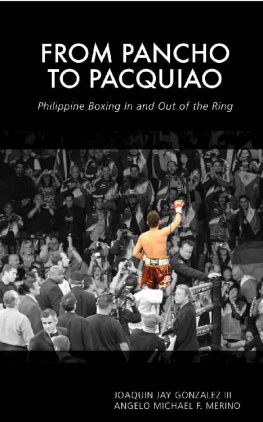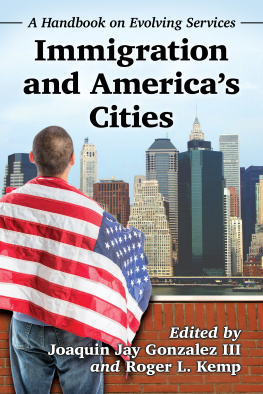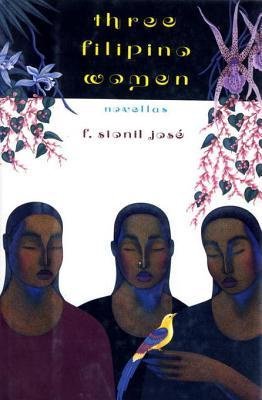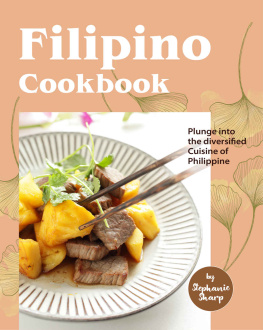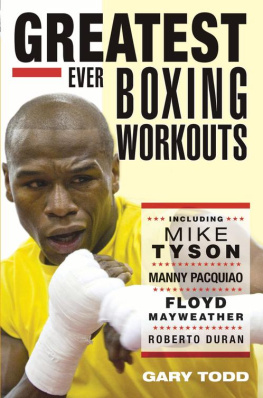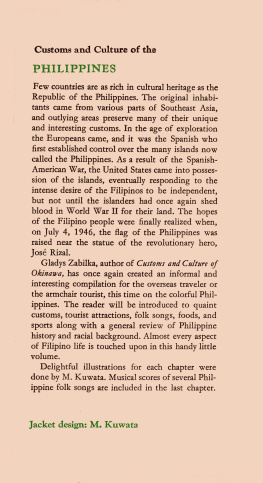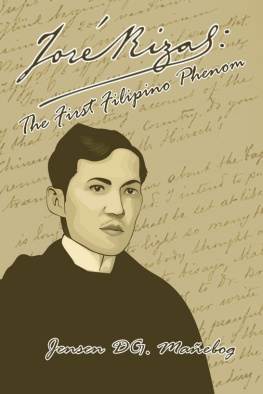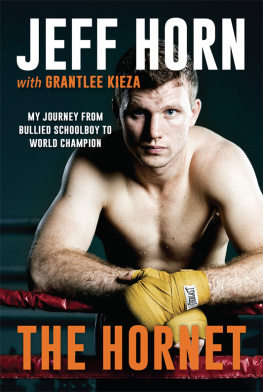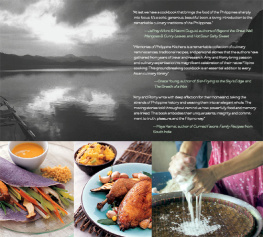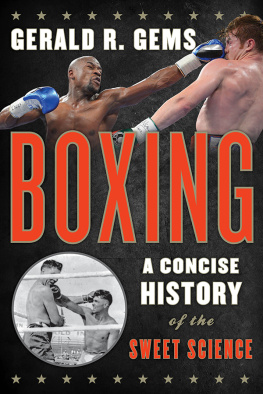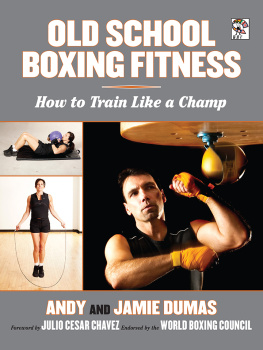As a boxing historian I enjoy researching and reading about fighters that are often overlooked and not given their just dues. Fighters from the Philippines fall into that category. Some hardcore boxing fans may disagree with some of these selections, but I nonetheless guarantee youll enjoy the profiles selected for this anthology.
Dan Cuoco, Director and Historian,
International Boxing Research Organization
Professors Gonzalez and Merino are two of the most gung-ho observers of Philippine boxing that I know. That they are based abroad makes them even more diligent in researching fact (and fable) about Filipino and Filipina boxing legends. The stories are fascinating and entertaining to read!
Ed Picson, Executive Director,
Amateur Boxing Association of the Philippines
Gonzalez and Merino have produced an enjoyable one of a kind sports memorabilia. The crisp biographies will knock you out. A must read for all boxing fans!
Joe Clough, Olympic gold medalist
and three-time U.S. Best Boxing Coach
This book is timely and enticing with the ascent of Manny Pacquiao as the most popular boxer in the world. Culture and sport have played an integral role in the lives of many Filipinos and the San Francisco Bay Area has a rich tradition. Gonzalez and Merinos research is long overdue and much of the information may surprise many.
Bill Hogan, Director of Athletics,
Seattle University, Washington
These profiles and selections of Filipino Boxers are outstanding. With current champion, Manny Pacquiao in the list, who wouldnt be excited? As a long time trainer and spectator I enjoy the rivalries between the Filipinos and Mexicanos. Great job!
Candelario Candy Lopez, San Jose State University
Head Coach and 2000 U.S. Olympic Boxing Coach
From Pancho to Pacquiao
Copyright to this digital edition 2013 by Joaquin Jay Gonzalez III,
Angelo Michael F. Merino, and Anvil Publishing, Inc.
All rights reserved.
No part of this publication may be reproduced, stored in a retrieval system, or transmitted in any form or by any meanswhether virtual, electronic, mechanical, photocopying, recording, or otherwisewithout the written permission of the copyright owner and the publisher.
Published by Anvil Publishing Inc. for De La Salle University-Manila by special arrangement.
Published and exclusively distributed by
ANVIL PUBLISHING, INC.
7th Floor, Quad Alpha Centrum
125 Pioneer Street, Mandaluyong City
1550 Philippines
Sales & Marketing: (632) 4774752, 4774755 to 57
Fax: (632) 7471622
www.anvilpublishing.com
ISBN 9789712728235 (e-book)
Cover photo by Ronnie Lu
Version 1.0.1
TABLE OF CONTENTS
Preface
From Pancho to Pacquiao is a snapshot of more than a century of Philippine boxing.
It is a compilation of lucid and readable biographies of outstanding Philippine-born and Filipino American boxers, from Francisco Pancho Villa Guilledo to Manny Peoples Champ Pacquiao. Each story describes the rough roads these Filipino and Filipina boxers took to achieve fame and glory globally. It highlights not only their ring triumphs and disappointing losses but also the ups and downs of their lives outside professional boxing.
What makes this book unique is that every biography is situated in the context of the Philippine migration experience as well as the evolving history of boxing in the United States, in the Asian region, and globally. Classic and contemporary photos and our personal conversations combine to make the narratives real and vivid.
The journey to writing From Pancho to Pacquiao: Philippine Boxing In and Out of the Ring began with two individuals who shared a love and passion for teaching and boxing. During our many exchanges, both inside and outside of the ring, we joked about the possibility of co-teaching a formal Philippine boxing course. Inspired by the successes of Manny Pacquiao, what began as What if was transformed into Lets do it! Hence, together we crafted a university course, Philippine Boxing and Culture, which combined both boxing as a sport and an academic subject. After the formal college curriculum approval, we debuted the course in a room filled with 16 eager faces in Spring 2010.
The experiment proved to be a knockout. Our initial group of students spread the word throughout the University of San Francisco (USF) campus. The demand was so high that two sections had to be offered every semester. Eventually, building on the success of this sports and culture class, we developed a more social justice-oriented course, Boxing and Social Justice, which was introduced in Fall 2011. Both courses were added as electives in the USFs Asian Studies Program and Yuchengco Philippine Studies Program. These are the first instances when Filipino-style boxing has been recognized as an academic subject outside of the Philippines.
In both Philippine boxing classes, we pieced together readily available materials we could find on this important but understudied subject. But since these were the only two courses of its kind in the globe, every time we taught, we always felt the burning desire to deviate from what was readily available. This was a sign that we had to develop our own textbooks. From Pancho to Pacquiao, is one of these projects.
Nonetheless, From Pancho to Pacquiao is a book not just for our students but also for all who call themselves boxing aficionados and sports fans around the planet. Read on!
1
PANCHO VILLA
Kung walang tiyaga, walang nilaga.
(If you dont persevere, you get no reward.)
We believe that the story of Philippine boxing is as much the story of centuries of Filipino movement back and forth, from the Philippines and the United States.
A requirement for one of our politics and social justice classes at the University of San Francisco was a tour of historical landmarks that commemorate Filipino presence in the city. We would walk city streets named after Philippine heroesLapu Lapu, Bonifacio, Tandang Sora, Rizal, and Mabini. The tour would end at the San Lorenzo Ruiz Senior Center building on 50 Rizal Street where a six-story high mural entitled Ang Lipi ni Lapu Lapu (The Descendants of Lapu Lapu) immortalizes some important personalities in Philippine and U.S. history.
Lapu Lapu, the fierce datu (chieftain) of Mactan (an island off the coast of Cebu province), is revered as the first Filipino hero. His tribe and its unique combat technique and strategy overwhelmed the European conquistador, Ferdinand Magellan, and his men.
Resisting attempts to be colonized, Lapu Lapu and his warriors were believed to have attacked them with an aggressive barrage, combining kampilan (swordsmanship), arnis or kali (stick fighting), and suntukan (fist fighting) skills. Thus, even with their superior weapons and armor, Magellan and his men were soundly defeated. Magellan himself was killed. Humiliated by the loss to uncivilized indios (natives), it took Spain another 50 years before sending its next expedition to Asia.
Gazing up at the imposing mural, our students would try to identify other familiar faces. One thought he recognized one of them, a brown-skinned boxer. Is that Manny Pacquiao? Good guess, but it is actually Pancho Villa, the first Filipino boxer who made his mark in American sports history decades before Manny Pacman Pacquiao.
Pancho Villa (August 1, 1901 - July 14, 1925) was the first Filipino and Asian world champion in boxing. Genetically, from Pancho to Pacquiao, Filipino boxers must have inherited their distinct speed (bilis) and power (lakas) from the cunning Lapu Lapu.
The oversized portrait of Pancho Villa in the San Francisco mural is somewhat deceptive because he was really a small man, just 51 and weighed only 114 pounds. He is the smallest of the outstanding Filipino professional boxers featured in this book. Despite his physical size, Pancho Villa is certainly not small in terms of his ring accomplishments. This is probably why muralists Johanna Poethig, Vic Clemente, and Presco Tabios portrayed him like a giant at the top center of their mural.
Next page
